
Sadegh Dabiri, Ph.D.
Assistant ProfessorSchool of Mechanical Engineering
Department of Ag & Bio Engineering
Purdue University
225 S. University St.
West Lafayette, IN 47907
Phone: 765-496-2044
E-mail: dabiri@purdue.edu
225 S. University St.
West Lafayette, IN 47907
Phone: 765-496-2044
E-mail: dabiri@purdue.eduDabiri research group focuses on developing advanced numerical techniques for accurate simulation of multiphase flows and using these techniques to understand the physics of multiphase flows in applications that include turbulent gas-liquid flows, cavitation and bubble dynamics, sprays and liquid atomization, heat transfer, mixing in supercritical conditions, and solid particles transport in fluids.
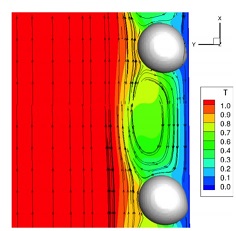
A two-phase flow is an excellent means for heat removal and has applications in different fields such as electronics, food industry, and the energy industry. The high rate of heat transfer associated with bubbly flows can be attributed to two important phenomena: Firstly, phase change, wherein a high heat transfer coefficient is observed due to the high latent heat of vaporization of the liquid phase; Secondly, the enhanced convective effect of bubbly flows. In the present study, we presents a numerical study of the heat transfer improvement around a bubble rising near a wall.
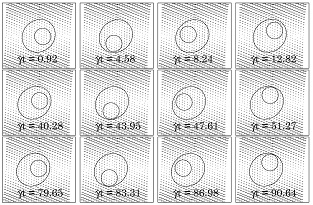
While the migration and deformation dynamics due to the surrounding flows are well known for single-phase droplets, the same cannot be said for compound droplets. We numerically examine the time-dependent behavior of double emulsions in a simple shear flow using finite volume and front-tracking methods. A inner drop is initially located eccentrically to the outer drop. When the eccentricity is contained within the plane of shear, the inner drop experiences a “revolving” motion within the plane of shear, orbiting about the center of the compound drop while slowly moving outward. The inner drop eventually experiences a limit cycle, where no more outward movement occurs because the distance between the two interfaces is reduced to a thin liquid film for portions of the revolving cycle. The inner droplet undergoes a “drifting” motion when eccentricity is in the direction normal to the plane of shear. The revolving and drifting motions are simultaneously observed when the in-plane-of-shear eccentricity is included in addition to the off-plane-of-shear eccentricity.
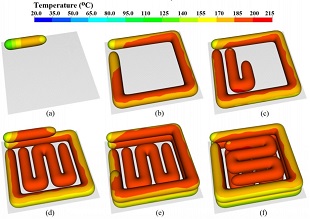
We developed a methodology for fully resolved numerical simulations of fusion deposition modeling. This work focuses on modeling the injection of hot polymer and its cooling down process.
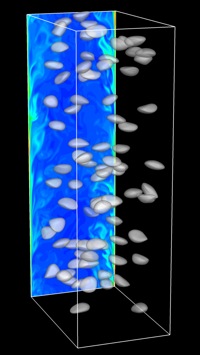
Direct Numerical Simulation of turbulent bubbly flows in a vertical channel with heated walls have been used to study the effect of the bubbly flow on the heat transfer rate and the temperature distribution in the channel. For the parameters considered in this study, a 3\% volume fraction of bubbles can increase the Nusselt number by 60\%. The largest increase in the Nusselt number occurs for low Eotvos numbers (Eo) and high Prandtl numbers. Nearly spherical bubbles rising near the wall stir up the viscous layer and reduce the size of the conduction region near the wall to improve the heat transfer rate. Although deformable bubbles do not come close to the wall, they nevertheless increase stirring sufficiently to increase the Nusselt number.
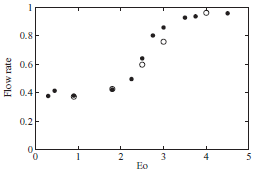
For bubbly upflow in a vertical channel, it is well known that spherical or nearly spherical bubbles hug the walls but deformable bubbles remain in the center of the channel. Here, we show that the transition from low flow rate channel with wall-hugging nearly spherical bubbles to high flow rate channels with deformable bubbles is sharp. It is shown that above the critical Eotvos number (Eo), the deformability of the bubbles has minor impact on the flow rate (at very high Eo, we would expect the bubbles to break into smaller bubbles so the assumption of a high Eo bubbles would not hold). It is shown that for Eo below the critical value the flow rate is approximately constant and much lower than for the deformable bubbles. In the transition region, between the low flow rate at low Eo and the high flow rate at high Eo, the flow rate depends strongly on the bubble deformability. Examination of the viscous dissipation profile across the channel shows a sudden increase of the peak value of dissipation at the wall when the bubbles enter the viscous sublayer which results in a decrease in the flow rate.
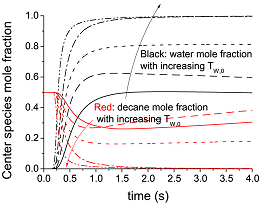
The mixing of a hydrocarbon droplet, containing a mixture of toluene and either n-decane or tetralin, in a reservoir of supercritical or near-critical water is modeled. The study provides microscale information, such as multi-component partitioning, and insight into large scale mixing in applications that include supercritical water oxidation, supercritical water desulfurization, etc. Transport, thermodynamics, and phase equilibrium sub-models are used to estimate the relevant physical properties. Results show that fractionation, i.e., the preferred dissolution of a specific hydrocarbon component into the water-rich phase, characterizes the transport and mixing process at various water temperatures. We find that the upper critical solution temperature (UCST) for binary water–HC mixtures control the mixing or fractionation of ternary water–HC–HC mixtures. Fractionation is: modest at water temperatures less than the water–toluene binary UCST (which is the lower UCST); substantial at water temperatures greater than the water–toluene binary UCST but less than the water–decane binary UCST (which is the higher UCST); and negligible at water temperatures greater than the ternary UCST. At water temperatures when fractionation is noticeable, the less water-soluble hydrocarbon (e.g., decane) composition in the droplet may increase over time and the water fraction in the droplet may go through a maximum, as more of the more water-soluble hydrocarbon (e.g., toluene) diffuses into the water-rich phase than the less water-soluble hydrocarbon. Varying the initial toluene concentration can either increase or decrease the droplet radius depending on the water temperature relative to the UCST's.

The deformation of a cavitation bubble in shear and extensional flows is studied numerically. The Navier–Stokes equations are solved to observe the three-dimensional behaviour of the bubble as it grows and collapses. During the collapse phase of the bubble, two re-entrant jets are observed on two sides of the bubble. The re-entrant jets are not the result of interaction with a solid wall or free surface; rather, they are formed due to interaction of the bubble with the background flow. Effects of the viscosity, surface tension and shear rate on the formation and strength of re-entrant jets are investigated. Re-entrant jets with enough strength break up the bubble into smaller bubbles. Post-processing and analysis of the results are done to cast the disturbance by the bubble on the liquid velocity field in terms of spherical harmonics. It is found that quadrupole moments are created in addition to the monopole source.